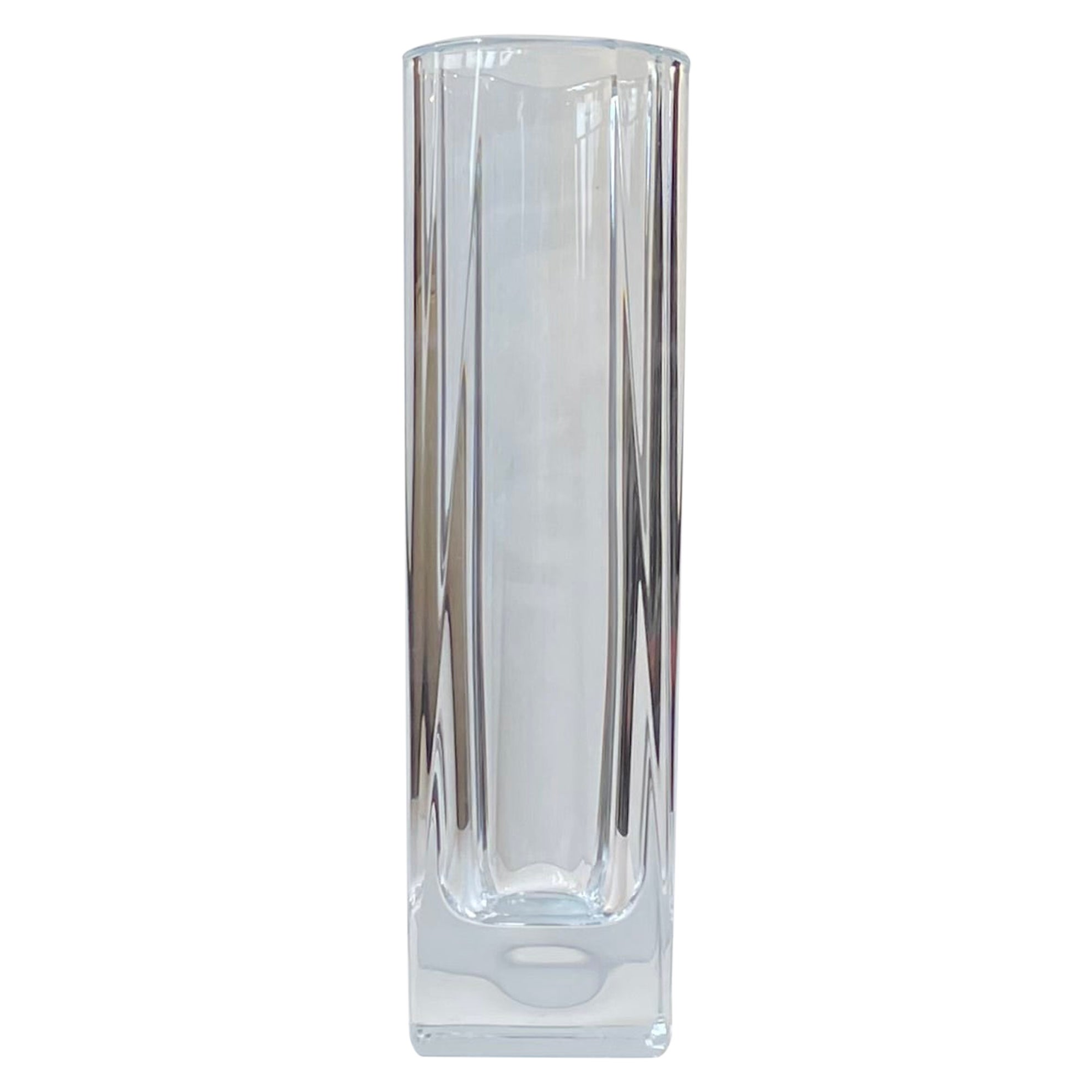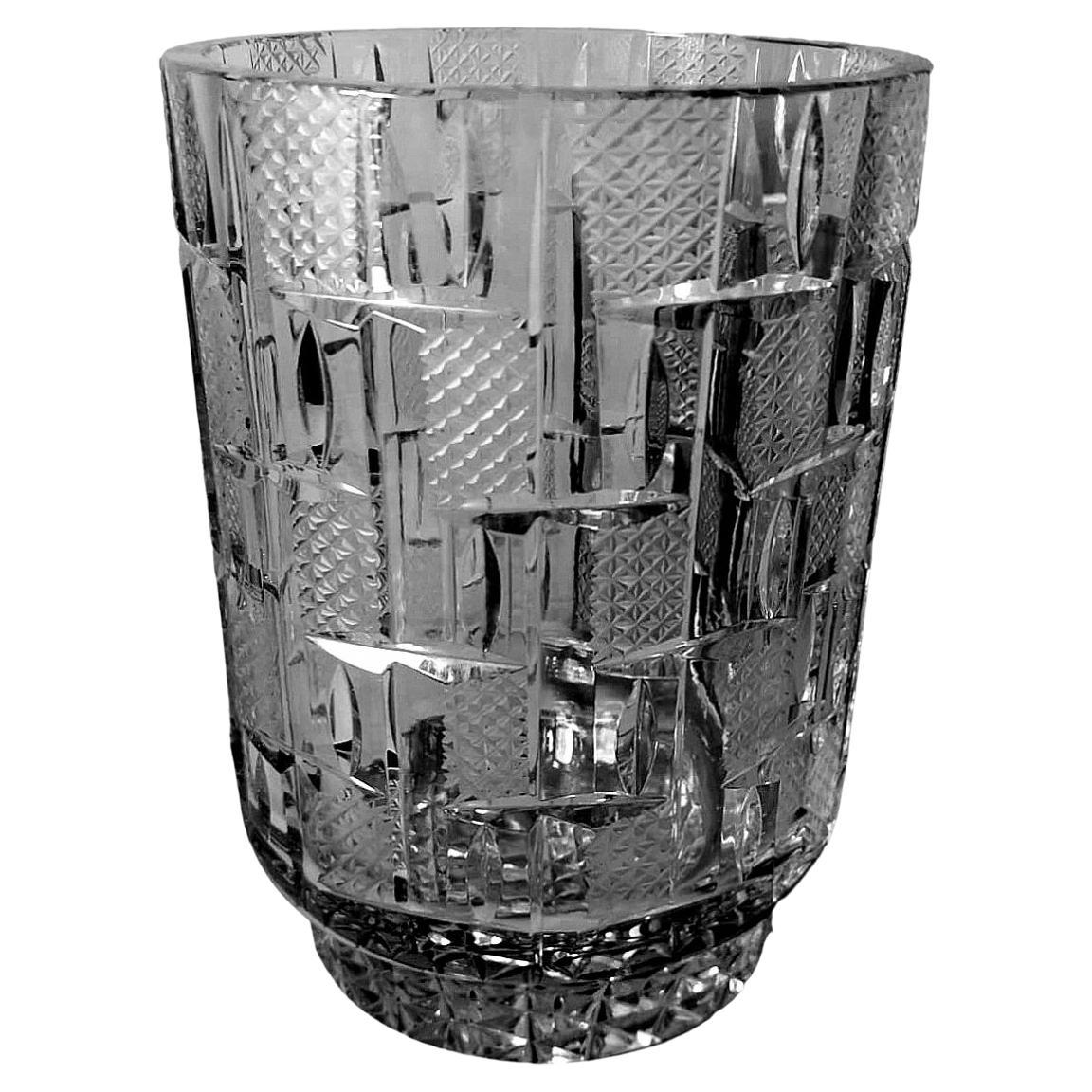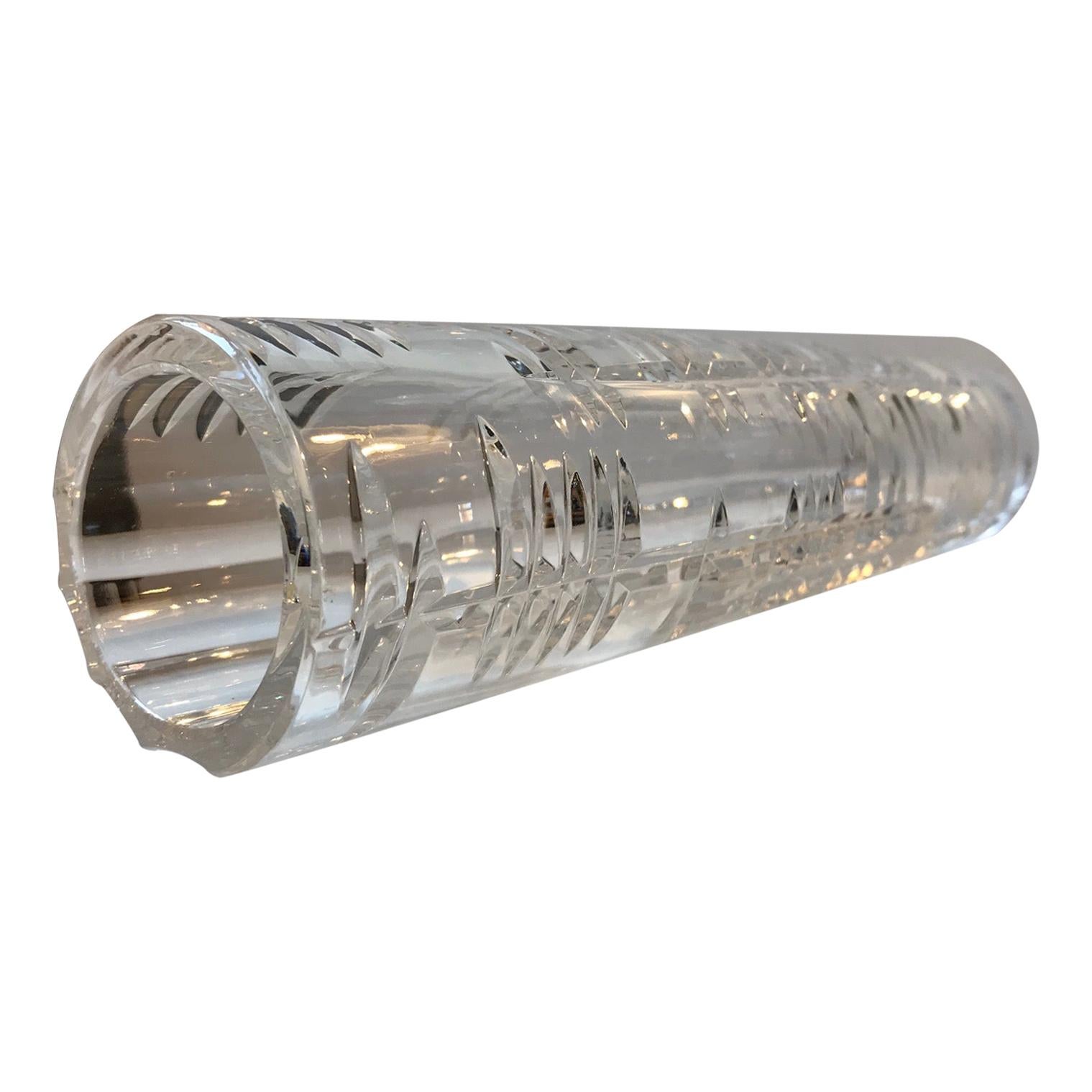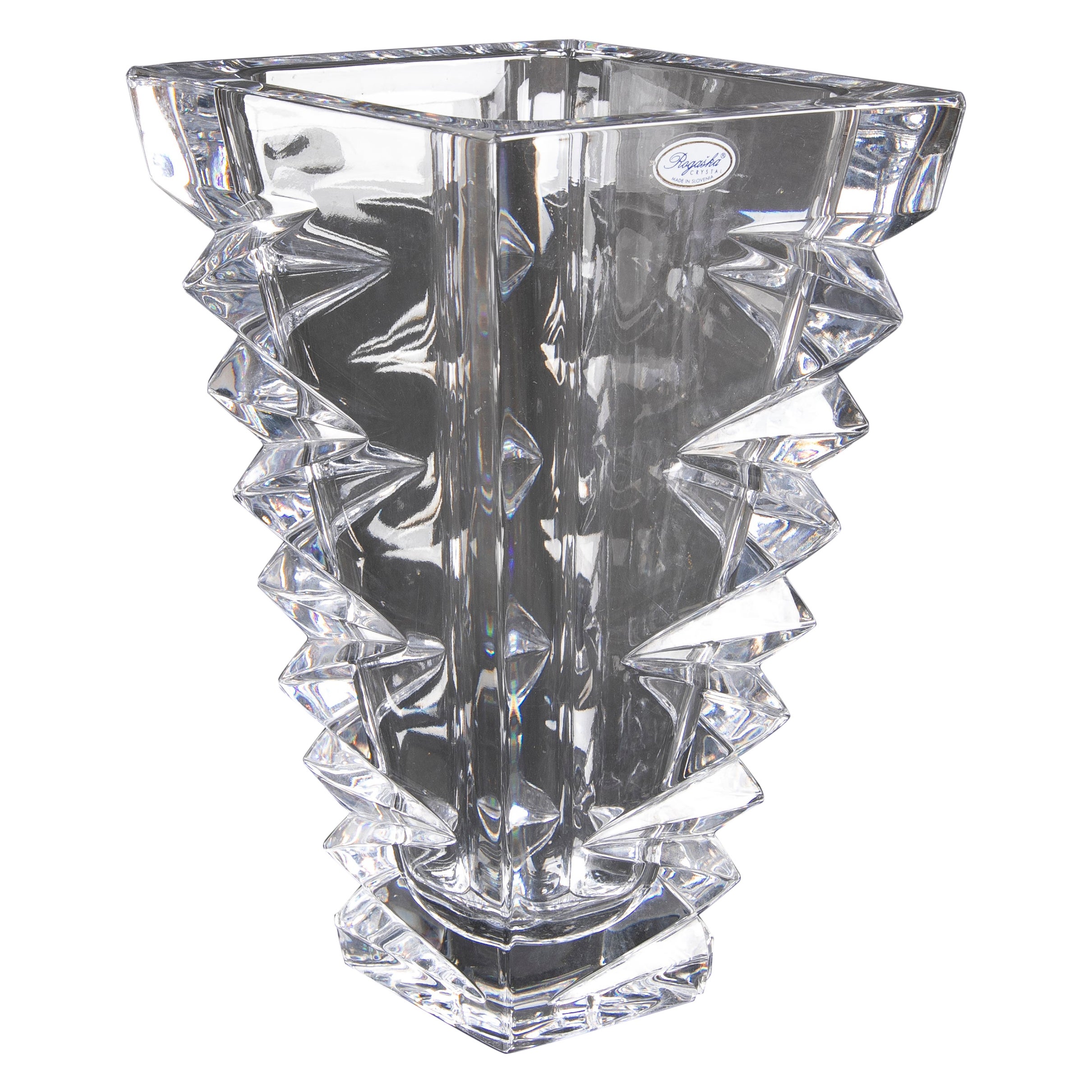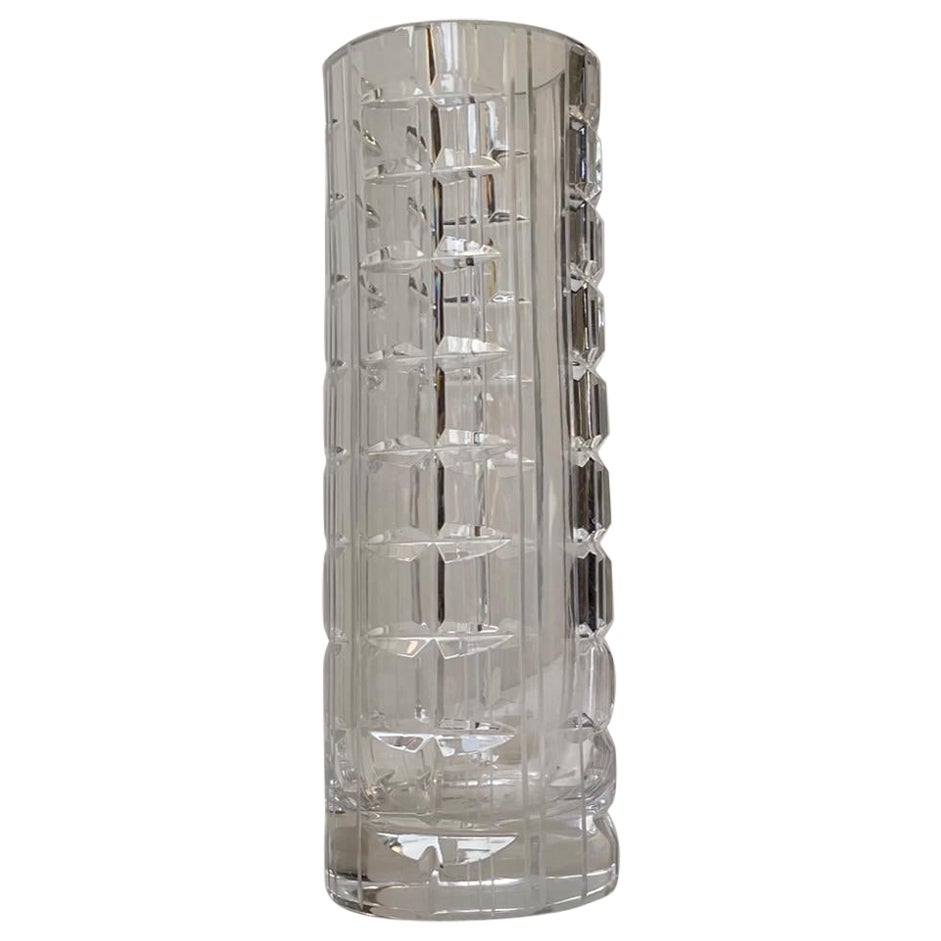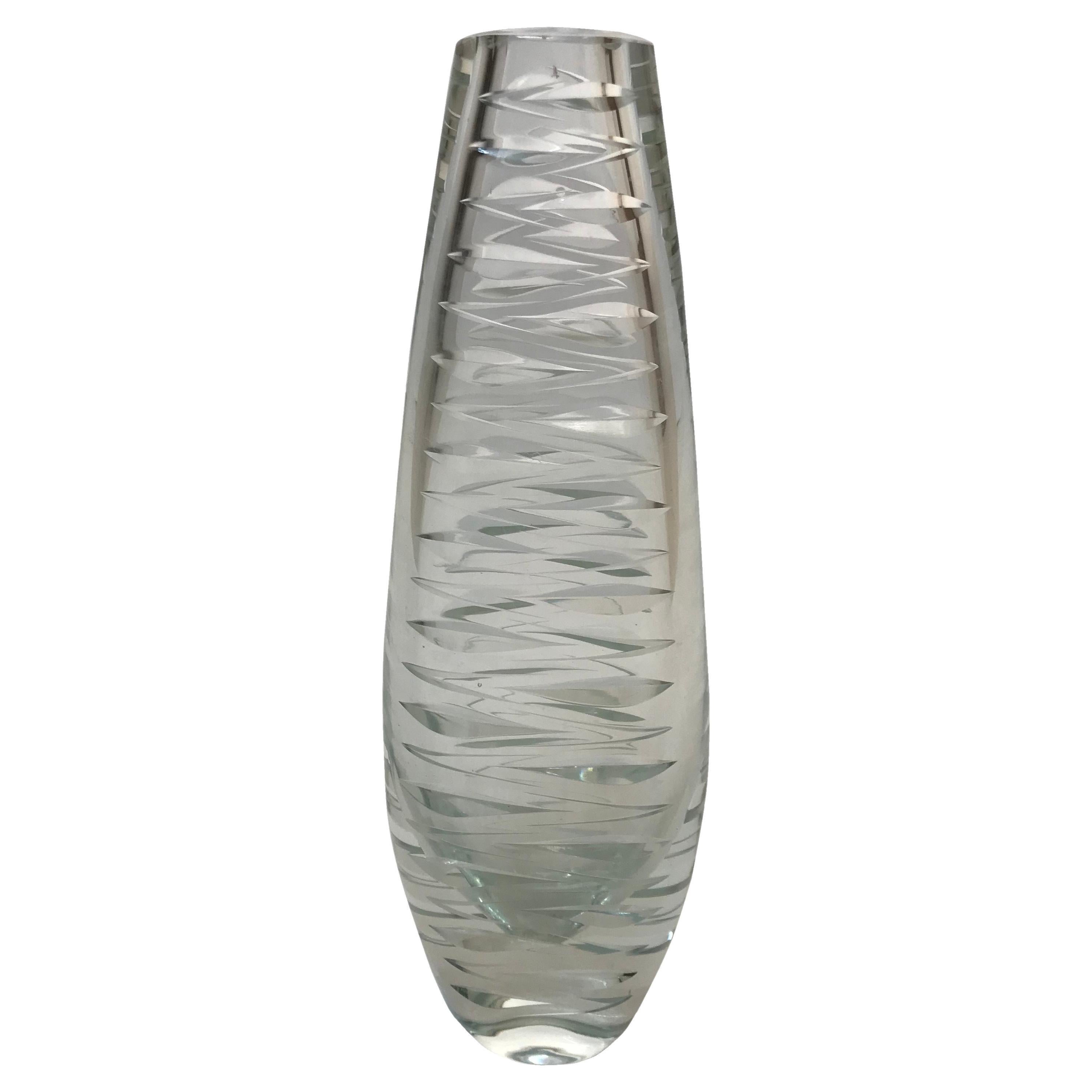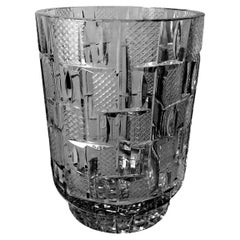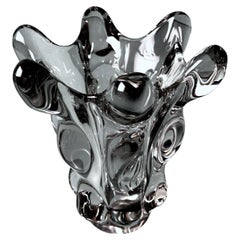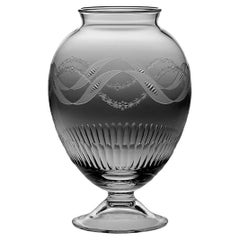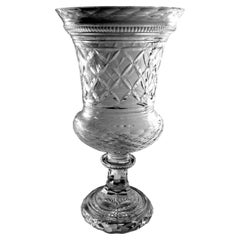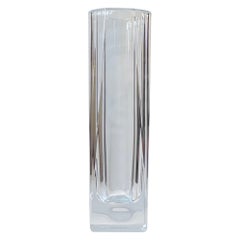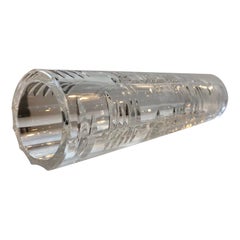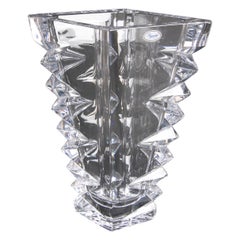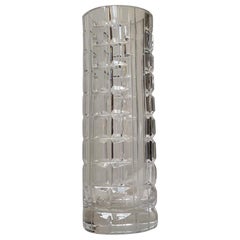Items Similar to Italian Craftsmanship Hand-Cut and Hand-Polished Beveled Crystal Vase
Video Loading
Want more images or videos?
Request additional images or videos from the seller
1 of 22
Italian Craftsmanship Hand-Cut and Hand-Polished Beveled Crystal Vase
$462.46
£343.81
€390
CA$640.89
A$714.46
CHF 372.62
MX$8,639.53
NOK 4,684.05
SEK 4,432.05
DKK 2,969.17
About the Item
We kindly suggest that you read the entire description, as we aim to provide detailed technical and historical information to guarantee the authenticity of our objects. This exceptional Italian lead crystal vase features a linear, simple, and well-proportioned shape. It is crafted from the highest quality lead crystal with a high thickness, allowing for deeper grinding than usual, which results in brighter and more brilliant light reflections. The geometry of the grinding is specially studied and executed to achieve this effect. This particular vase was created between 1970 and 1974 in an artisan workshop in Colle di Val D'Elsa, Siena, Italy. The master craftsmen of this Tuscan town enhanced the high refractive index of the vase by following traditional and complex glassmaking techniques. After coming out of the kiln in its final shape and being slowly cooled, the vase underwent several meticulous steps:
1. Cutting and Grinding: Using an emery wheel continuously fed by a jet of abrasive sand and water.
2. Re-Polishing: Using a very fine-grained sandstone wheel also fed with water.
3. Polishing: Using a cork bark wheel wet with a mush of water and pumice to make the surfaces more transparent.
4. Final Polishing: Achieved with a felt wheel wet with a mush of water, iron oxide, and cerium oxide.
Crystal craftsmanship originated in the beautiful medieval Tuscan village of Colle Val D'Elsa around 1300, thanks to the abundance of three natural elements: sand, water, and wood. These were fundamental in giving birth to the first glassmaking industry. With the advent of machinery, the glass industry expanded significantly in the 19th century. In 1963, after significant investments and experimentation in Colle Val d'Elsa, where both artisanal and industrial production coexisted successfully, it became possible to produce glass containing more than 24 percent lead oxide. This glass competed in brilliance and achromaticity with that from England, France, and Belgium, where the tradition of leaded glass was centuries old. Colle di Val d'Elsa produces 95 percent of Italy's crystal and 15 percent of the world's, earning it the nickname "Bohemia of Italy."The artisans of Colle Val D'Elsa, absolute masters of their craft, have used these precise and complex processes to imbue our vase with exceptional brightness, transparency, and brilliance, making it a unique and precious work of art. The vase is in good condition and measures 9 cm in width, 9 cm in depth, and 30 cm in height. For all our shipments, we use special packaging materials (custom-made wooden crates, styrofoam, etc.) to ensure maximum protection and safety of the objects.
- Dimensions:Height: 11.82 in (30 cm)Width: 3.55 in (9 cm)Depth: 3.55 in (9 cm)
- Style:Modern (Of the Period)
- Materials and Techniques:
- Place of Origin:
- Period:
- Date of Manufacture:1970-1974
- Condition:Wear consistent with age and use. The vase is in good condition.
- Seller Location:Prato, IT
- Reference Number:Seller: 148491stDibs: LU4632239950182
About the Seller
5.0
Platinum Seller
Premium sellers with a 4.7+ rating and 24-hour response times
Established in 1977
1stDibs seller since 2019
286 sales on 1stDibs
Typical response time: 1 hour
- ShippingRetrieving quote...Shipping from: PRATO, Italy
- Return Policy
Authenticity Guarantee
In the unlikely event there’s an issue with an item’s authenticity, contact us within 1 year for a full refund. DetailsMoney-Back Guarantee
If your item is not as described, is damaged in transit, or does not arrive, contact us within 7 days for a full refund. Details24-Hour Cancellation
You have a 24-hour grace period in which to reconsider your purchase, with no questions asked.Vetted Professional Sellers
Our world-class sellers must adhere to strict standards for service and quality, maintaining the integrity of our listings.Price-Match Guarantee
If you find that a seller listed the same item for a lower price elsewhere, we’ll match it.Trusted Global Delivery
Our best-in-class carrier network provides specialized shipping options worldwide, including custom delivery.More From This Seller
View AllItalian Midcentury Large Crystal Vase Ground, Cut, And Polished By Hand
Located in Prato, Tuscany
Please kindly read the entire description, as we aim to provide you with detailed technical and historical information to ensure the authenticity of our objects.
This exceptional Ita...
Category
Late 20th Century Italian Mid-Century Modern Vases
Materials
Crystal
Art Deco, French Lead Crystal Vase In The Vannes-Le-Châtel Style
By Art Vannes
Located in Prato, Tuscany
We kindly invite you to read the full description, as it offers detailed technical and historical information to assure you of the authenticity of our pieces.
This is an exceptional and significant clear lead...
Category
Mid-20th Century French Art Deco Vases
Materials
Crystal
Neoclassical Style Italian Crystal Vase With Festoon Engravings
Located in Prato, Tuscany
Before describing the object under consideration we must make an important clarification; the artifact, one of many that we will publish over time, is part of the museum collection of a historic Florentine crystal grinder that unfortunately closed recently. It is the Marcello Galgani & Son company, whose completely manual and artisanal work has not withstood the disproportionate advance of mass-produced mechanical processes! Marcello Galgani began his craft as a grinder and restorer in 1960; as the years went by, Marcello mastered and became familiar with particular techniques and shapes, resulting in the production of objects that manage to retain the freshness of grinding and engraving, the warmth and softness of light, and the inimitable flavor of unique artifacts. After several years, his son Lorenzo, who grew up among crystals, also entered the business and immediately became passionate about this ancient craft with skill and ability. Stimulated by the aesthetic sense of the past, father and son, set up a workshop in which the shapes they researched and created themselves are mouth-blown by traditional Tuscan glassmakers in Empoli, then ground and engraved using ancient sixteenth-century techniques, with motifs born of the Galgani's inexhaustible imagination or culturally inspired by designs of objects seen and studied in Florentine museums (Uffizi, Galleria Palatina, Museo degli Argenti, etc.). Marcello and Lorenzo Galgani were also Masters in the difficult art of restoration, bringing rare and precious objects back to life. As mentioned the company recently closed and disposed of all its last production, only Marcello's old private museum collection remained, which includes unique and special objects created over time, a collection that the craftsman made available to us for a planned sale. All of the objects were made entirely by hand with old grinding wheels, but there were mainly two tools that allowed the creation of masterpieces: the right hand and the left hand of the master craftsman. Ancient glassmaking techniques were used for all the ground and engraved products: first the object was ground with an emery wheel fed continuously by a jet of abrasive sand and water, then re-polished with a very fine-grained sandstone wheel also fed with water; the engravings were done freehand using as many as 10-15 small stone wheels for each design (flowers, branches, animals, etc. ); then the object was polished and shined; we must make, at this point, an important clarification on these last two operations: towards the end of the 1960s acid crystal polishing was devised, the object was immersed and rotated in a solution of sulfuric acid, fluoridic acid and water and in a short time all the defects left by the previous processes were eliminated, it was a fast, industrial operation that allowed to lower costs considerably, with discrete but not excellent results. But for Galgani's products polishing is done with a cork bark wheel wet with water and pumice, to make the surfaces more transparent. Finally, polishing was achieved with a felt wheel wet with a paste of water, iron oxide, and cerium oxide. This series of processes takes an average of two days of work( sometimes much longer) for each object, each engraving or grinding is the result of the creative inventiveness of the two craftsmen, inventiveness that transforms crystal into a material reality of the highest aesthetic value and inestimable value. All objects in the entire collection have never been used; they were part of the exhibition. Large oval crystal vase...
Category
Late 20th Century Italian Neoclassical Vases
Materials
Crystal
Florentine Renaissance Style Huge Italian Cut And Ground Crystal Medici Vase
Located in Prato, Tuscany
Before describing the object under consideration, we must make an important clarification; the artifact, one of many that we will publish over time, is part of the museum collection of a historic Florentine crystal grinder that unfortunately closed recently. It is the Marcello Galgani & Son company, whose completely manual and artisanal work has not withstood the disproportionate advance of mass-produced mechanical processes! Marcello Galgani began his craft as a grinder and restorer in 1960; as the years went by, Marcello mastered and became familiar with particular techniques and shapes, resulting in the production of objects that manage to retain the freshness of grinding and engraving, the warmth and softness of light, and the inimitable flavor of unique artifacts. After several years, his son Lorenzo, who grew up among crystals, also entered the business and immediately became passionate about this ancient craft with skill and ability. Stimulated by the aesthetic sense of the past, father and son, set up a workshop in which the shapes they researched and created themselves are mouth-blown by traditional Tuscan glassmakers in Empoli, then ground and engraved using ancient sixteenth-century techniques, with motifs born from the Galgani's inexhaustible imagination or culturally inspired by designs of objects seen and studied in Florentine museums (Uffizi, Galleria Palatina, Museo degli Argenti, etc.). Marcello and Lorenzo Galgani were also Masters in the difficult art of restoration, bringing rare and precious objects back to life. As mentioned the company recently closed and disposed of all its last production, and only Marcello's old private museum collection remained, which includes unique and special objects created over time, a collection that the craftsman made available to us for a planned sale. All of the objects were made entirely by hand with old grinding wheels, but there were mainly two tools that allowed the creation of masterpieces: the right hand and the left hand of the master craftsman. Ancient glassmaking techniques were used for all the ground and engraved products: first, the object was ground with an emery wheel fed continuously by a jet of abrasive sand and water, then re-polished with a very fine-grained sandstone wheel also fed with water; the engravings were done freehand using as many as 10-15 small stone wheels for each design (flowers, branches, animals, etc. ); then the object was polished and shined; we must make, at this point, an important clarification on these last two operations: towards the end of the 1960s acid crystal polishing was devised, the object was immersed and rotated in a solution of sulfuric acid, fluoridic acid and water and in a short time all the defects left by the previous processes were eliminated, it was a fast, industrial operation that allowed to lower costs considerably, with discrete but not excellent results. But for Galgani's products polishing is done with a cork bark wheel wet with water and pumice, to make the surfaces more transparent, and finally polishing was achieved with a felt wheel wet with a paste of water, iron oxide, and cerium oxide. This series of processes takes an average of two days of work( sometimes much longer) for each object, each engraving or grinding is the result of the creative inventiveness of the two artisans, inventiveness that transforms crystal into reality material of the highest aesthetic value and inestimable value. All the items in the entire collection have never been used; they were part of the exhibition. Huge and monumental Florentine Renaissance-style vase...
Category
Late 20th Century Italian Renaissance Vases
Materials
Crystal
Neoclassical Style Large Italian Crystal Vase with 18th Century Engravings
Located in Prato, Tuscany
Before describing the object under consideration, we must make an important clarification; the artifact, one of many that we will publish over time, is part of the museum collection of a historic Florentine crystal grinder that unfortunately closed recently. It is the Marcello Galgani & Son company, whose completely manual and artisanal work has not withstood the disproportionate advance of mass-produced mechanical processes! Marcello Galgani began his craft as a grinder and restorer in 1960; as the years went by, Marcello mastered and became familiar with particular techniques and shapes, resulting in the production of objects that manage to retain the freshness of grinding and engraving, the warmth and softness of light, and the inimitable flavor of unique artifacts. After several years, his son Lorenzo, who grew up among crystals, also entered the business and immediately became passionate about this ancient craft with skill and ability. Stimulated by the aesthetic sense of the past, father and son, set up a workshop in which the shapes they researched and created themselves are mouth-blown by traditional Tuscan glassmakers in Empoli, then ground and engraved using ancient sixteenth-century techniques, with motifs born from the Galgani's inexhaustible imagination or culturally inspired by designs of objects seen and studied in Florentine museums (Uffizi, Galleria Palatina, Museo degli Argenti, etc.). Marcello and Lorenzo Galgani were also Masters in the difficult art of restoration, bringing rare and precious objects back to life. As mentioned the company recently closed and disposed of all its last production, and only Marcello's old private museum collection remained, which includes unique and special objects created over time, a collection that the craftsman made available to us for a planned sale. All of the objects were made entirely by hand with old grinding wheels, but there were mainly two tools that allowed the creation of masterpieces: the right hand and the left hand of the master craftsman. Ancient glassmaking techniques were used for all the ground and engraved products: first, the object was ground with an emery wheel fed continuously by a jet of abrasive sand and water, then re-polished with a very fine-grained sandstone wheel also fed with water; the engravings were done freehand using as many as 10-15 small stone wheels for each design (flowers, branches, animals, etc. ); then the object was polished and shined; we must make, at this point, an important clarification on these last two operations: towards the end of the 1960s acid crystal polishing was devised, the object was immersed and rotated in a solution of sulfuric acid, fluoridic acid and water and in a short time all the defects left by the previous processes were eliminated, it was a fast, industrial operation that allowed to lower costs considerably, with discrete but not excellent results. But for Galgani's products polishing is done with a cork bark wheel wet with water and pumice, to make the surfaces more transparent, and finally polishing was achieved with a felt wheel wet with a paste of water, iron oxide, and cerium oxide. This series of processes takes an average of two days of work( sometimes much longer) for each object, each engraving or grinding is the result of the creative inventiveness of the two artisans, inventiveness that transforms crystal into reality material of the highest aesthetic value and inestimable value. All the items in the entire collection have never been used; they were part of the exhibition. Large crystal vase with base; the decorations, graceful and delicate, are in Neoclassical style. The object is "one-of-a-kind" signed by the Master; it was created in Marcello Galgani's workshop in 1981 and made with the techniques (grinding, engraving, and polishing) we explained in the description; for the shape, the Master was inspired by a vase found in a painting, preserved in the Uffizi Gallery in Florence by the 16th-century painter Jacopo Ligozzi...
Category
Late 20th Century Italian Neoclassical Vases
Materials
Crystal
Baroque Style Large Italian Crystal Vase With Grotesque Engravings
Located in Prato, Tuscany
Before describing the object under consideration, we must make an important clarification; the artifact, one of many that we will publish over time, is part of the museum collection of a historic Florentine crystal grinder that unfortunately closed recently. It is the Marcello Galgani & Son company, whose completely manual and artisanal work has not withstood the disproportionate advance of mass-produced mechanical processes! Marcello Galgani began his craft as a grinder and restorer in 1960; as the years went by, Marcello mastered and became familiar with particular techniques and shapes, resulting in the production of objects that manage to retain the freshness of grinding and engraving, the warmth and softness of light, and the inimitable flavor of unique artifacts. After several years, his son Lorenzo, who grew up among crystals, also entered the business and immediately became passionate about this ancient craft with skill and ability. Stimulated by the aesthetic sense of the past, father and son, set up a workshop in which the shapes they researched and created themselves are mouth-blown by traditional Tuscan glassmakers in Empoli, then ground and engraved using ancient sixteenth-century techniques, with motifs born from the Galgani's inexhaustible imagination or culturally inspired by designs of objects seen and studied in Florentine museums (Uffizi, Galleria Palatina, Museo degli Argenti, etc.). Marcello and Lorenzo Galgani were also Masters in the difficult art of restoration, bringing rare and precious objects back to life. As mentioned the company recently closed and disposed of all its last production, and only Marcello's old private museum collection remained, which includes unique and special objects created over time, a collection that the craftsman made available to us for a planned sale. All of the objects were made entirely by hand with old grinding wheels, but there were mainly two tools that allowed the creation of masterpieces: the right hand and the left hand of the master craftsman. Ancient glassmaking techniques were used for all the ground and engraved products: first, the object was ground with an emery wheel fed continuously by a jet of abrasive sand and water, then re-polished with a very fine-grained sandstone wheel also fed with water; the engravings were done freehand using as many as 10-15 small stone wheels for each design (flowers, branches, animals, etc. ); then the object was polished and shined; we must make, at this point, an important clarification on these last two operations: towards the end of the 1960s acid crystal polishing was devised, the object was immersed and rotated in a solution of sulfuric acid, fluoridic acid and water and in a short time all the defects left by the previous processes were eliminated, it was a fast, industrial operation that allowed to lower costs considerably, with discrete but not excellent results. But for Galgani's products polishing is done with a cork bark wheel wet with water and pumice, to make the surfaces more transparent, and finally polishing was achieved with a felt wheel wet with a paste of water, iron oxide, and cerium oxide. This series of processes takes an average of two days of work( sometimes much longer) for each object, each engraving or grinding is the result of the creative inventiveness of the two artisans, inventiveness that transforms crystal into reality material of the highest aesthetic value and inestimable value. All the items in the entire collection have never been used; they were part of the exhibition. Large crystal vase; the decorations, in baroque style represent a series of "grotesques" The object is "a unique piece" signed by the Master, it was created in Marcello Galgani's workshop in 1983 and made with the techniques (grinding, engraving and polishing) that we explained in the description; for the shape, the Master was inspired by a vase present in a painting, preserved in the Uffizi Gallery in Florence by the sixteenth-century painter Jacopo Ligozzi...
Category
Late 20th Century Italian Baroque Vases
Materials
Crystal
You May Also Like
French Art Deco Cut Crystal Vase in the style of Daum, 1930s
By Daum
Located in Esbjerg, DK
Strictly cut rectangular cristal vase - vastly faceted vertically. Unknown French maker in the style of Daum. No markings. It measures 26.5 cm in height and has a top-width 8x8 cm. I...
Category
Vintage 1930s French Art Deco Vases
Materials
Crystal
$333 Sale Price
25% Off
Scandinavian Cut Crystal Vase, 1950s
Located in Esbjerg, DK
A cut crystal torpedo shaped vase presumably from either Kosta Boda or Orrefors. The vase features diffrent techniques most prominent is the mix of vertical ribbing to one side and a...
Category
Vintage 1950s Scandinavian Scandinavian Modern Vases
Materials
Crystal
$311 Sale Price
25% Off
Handmade Solid Crystal Vase
Located in Marbella, ES
Handmade Solid Crystal Vase.
Category
Late 20th Century Spanish Jars
Materials
Glass
$1,233 Sale Price
20% Off
Scandinavian Modern Cut Crystal Vase, 1950s
Located in Esbjerg, DK
A cut crystal torpedo shaped vase presumably from either Kosta Boda or Orrefors. It features diffrent techniques most prominent the mix of vertical ribbings and geometric patterns. I...
Category
Vintage 1950s Scandinavian Scandinavian Modern Vases
Materials
Crystal
$222 Sale Price
25% Off
Crystal vase , 1930
Located in Ciudad Autónoma Buenos Aires, C
Vase of Crystal
We have specialized in the sale of Art Deco and Art Nouveau and Vintage styles since 1982. If you have any questions we are at your disposal.
Pushing the button that...
Category
Vintage 1930s Swedish Art Deco Crystal Serveware
Materials
Crystal
$6,000
Ambrosià handcrafted Crystal Flower Vase
Located in Glendale, CA
Ambrosià Crystal Flower Vase – Hand-Cut Art Deco Home Jewelry
The Ambrosià Crystal Flower Vase is a stunning embodiment of luxury home décor, blending t...
Category
2010s Modern Vases
Materials
Crystal
$432 Sale Price / item
20% Off
More Ways To Browse
Industrial Crate
Feder Light
Brilliant Cut Glass Crystal
Wooden Wheel
Tuscan Iron Furniture
Bark Vases
Bohemia Crystal Vintage
Bohemia Cut Crystal
Leaded Cut Crystal Vase
Tuscan Vase
Cut Glass Lead Crystal Vase
French Lead Crystal Vase
Vintage Bohemia Crystal Vase
Antique White Plant Stand
Blown Feather Glass
Hexagon Porcelain
Polish Pottery Used
19th Century Lacquer Vases
